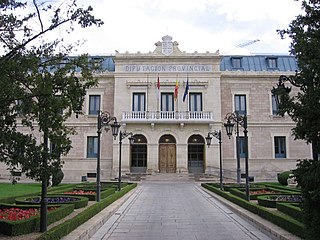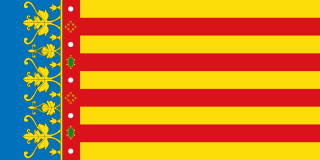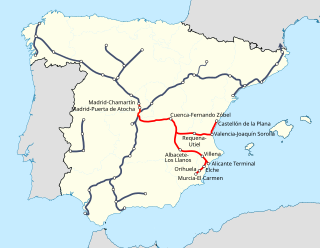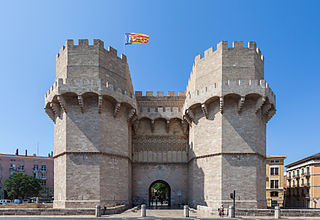
Cuenca is one of the five provinces of the autonomous community of Castilla-La Mancha. It is located in the eastern part of this autonomous community and covers 17,141 square km. It has a population of 203,841 inhabitants – the least populated of the five provinces. Its capital city is also called Cuenca.

Los Serranos is a comarca in the province of Valencia, Valencian Community, Spain. It is part of the Spanish-speaking area in the Valencian Community.

Camp de Túria is a comarca in the province of Valencia, Valencian Community, Spain.
Camporrobles is a municipality in the comarca of Requena-Utiel in the Valencian Community, Spain.

Chera is a municipality in the comarca of Requena-Utiel in the Valencian Community, Spain. The name in Valencian is Xera, but the local language is Spanish, not Valencian.
Caudete de las Fuentes is a municipality in the comarca of Requena-Utiel in the Valencian Community, Spain.
Utiel is a municipality in the comarca of Plana de Utiel in the Valencian Community, Spain.

Venta del Moro is a municipality in the comarca of Requena-Utiel in the Valencian Community, Spain.

Villargordo del Cabriel is a municipality in the comarca of Requena-Utiel in the Valencian Community, Spain.

Utiel Requena is a Spanish Denominación de Origen Protegida (DOP) for wines located in the province of Valencia. It takes its name from the two neighbouring towns of Utiel and Requena. It is renowned for the predominant use of the Bobal grape variety.

The Valencian Community is an autonomous community of Spain. It is the fourth most populous Spanish autonomous community after Andalusia, Catalonia and the Community of Madrid with more than five million inhabitants. Its homonymous capital Valencia is the third largest city and metropolitan area in Spain. It is located along the Mediterranean coast on the east side of the Iberian Peninsula. It borders with Catalonia to the north, Aragon and Castilla–La Mancha to the west, and Murcia to the south, and the Balearic Islands are to its east. The Valencian Community consists of three provinces which are Castellón, Valencia and Alicante.

Manchuela or La Manchuela is a comarca located in Castile-La Mancha and Valencian Community, Spain.

The Madrid–Levante high-speed network is a network of high-speed rail lines that connects Madrid with the Mediterranean coast of the Levante Region, specifically with Castilla-La Mancha, the Valencian Community and the Murcia Region autonomous communities.

Valencians are the native people of the Valencian Community, in eastern Spain. Legally, Valencians are the inhabitants of the community. Since 2006, the Valencian people are officially recognised in the Valencian Statute of Autonomy as a nationality "within the unity of the Spanish nation". The official languages of Valencia are Valencian and Spanish.

Sierra de Utiel is a 16.45 km (10 mi) long mountain range in the Alt Palància, Alt Millars and Plana Baixa comarcas, Valencian Community, Spain. Its highest point is the 1,306 m high El Remedio. There is often snow in the winter.

Valencia is a province of Spain, in the central part of the autonomous Valencian Community. Of the province's over 2.5 million people (2018), one-third live in the capital, Valencia, which is also the capital of the autonomous community and the 3rd biggest city in Spain, with a metropolitan area of 2,522,383 people it is also one of the most populated cities of Southern Europe. There are 265 municipalities in the province.

The Serrans Gate or Serranos Gate, also known as Serrans Towers or Serranos Towers is one of the twelve gates that formed part of the ancient city wall, the Christian Wall, of the city of Valencia, Spain. It was built in Valencian Gothic style at the end of the 14th century. Its name is probably due to its location in the northeast of the old city centre, making it the entry point for the royal road connecting Valencia with the comarca or district of Els Serrans as well as the entry point for the royal road to Barcelona, or because the majority of settlers near there in the time of James I of Aragon were from the area around Teruel, whose inhabitants were often called serrans by the Valencians. Alternatively, the gate may also have been named after an important family, the Serrans, who lived in a street with the same name.

Consuelo Mata Parreño is a Spanish Teacher who specialises in Iberian material culture. She is currently the head teacher of the Department of Archaeology at the University of Valencia.

María Teresa Oller was a Spanish composer and folklorist of the Valencian Community. Since the 1950s, she carried out extensive fieldwork to collect traditional Valencian music, highlight it, and make it known in numerous publications. Oller was a member of the Real Academia de Bellas Artes de San Carlos de Valencia.

















